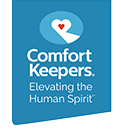Ensuring that your senior loved one remains as self-sufficient as possible, and yet safe around the house requires a delicate balance. For those caring for a person with Alzheimer’s or other forms of dementia, that challenge increases ten-fold. Caregivers providing care for someone with Alzheimer’s must be diligent about identifying potential dangers in the home. Dangers such as throw rugs, inadequate lighting, loose baseboards and many seemingly innocent household challenges can prove to be catastrophic when caring for someone with Alzheimer’s. It may seem like a daunting task to identify all of the risks in a home and then take corrective action, but it’s easier if you address hazards room-by-room.
Senior Safety in the Bedroom
One of the most common hazards in the bedroom is inadequate lighting. Bedroom lighting is typically low and soft for comfort. But if something as simple as reaching for the television remote control is no longer an easy thing to do, and your loved one gets up to retrieve the item, you may be risking a preventable fall. While lighting during the night keeps some people awake, a nightlight might be a lifesaver for someone with Alzheimer’s. Also, make sure bed clothing fits appropriately to prevent accidents.
Many caregivers have found creating some kind of communication system such as an intercom or bell can alleviate the risk of accidents.
Senior Safety in the Bathroom
In the early stages of Alzheimer’s, many people can perform basic hygiene, although someone should always remain close. To help preserve your loved one’s independence as long as possible, consider installing these devices:
- Raised toilet seats
- Grab or side bars on and around the tub and toilet areas
- Non-skid mats in the tub and a safe, non-skid floor surface
Getting in and out of the tub is often quite frightening for those with Alzheimer’s, as well as their caregivers, so consider using a stool or shower chair to reduce the apprehension and fear of falling. Additional bathroom safety tips include: - Remove items from shelving.
- Ensure the water temperature on the house meter is no higher than 120-degrees.
Senior Safety in the Kitchen
The kitchen is likely the most dangerous room in the home for anybody, but especially for those with cognitive issues.
Preventing risks in the kitchen starts with a careful evaluation of your loved one’s cognitive abilities. If it is not safe for your loved one to cook without someone supervising, then prepare meals ahead when someone can oversee the process. Keeping someone with cognitive challenges involved in those things he/she has loved doing – like cooking- is a great way to keep someone inspired and feel as though he/she is contributing. But don’t take any unnecessary risks. Cook ahead of time and store meals in microwaveable containers.
If your loved one’s condition worsens, you may have to take greater control by removing metal cans that might accidentally get microwaved, and disabling appliances—not just in the kitchen but throughout the home—when you are not there. Keep surfaces clear of items and appliances such as crockpots and toasters (and hair dryers in the bath).
If your loved one is still relatively self-sufficient in the kitchen, use labels to describe individual items, or the contents of drawers and cupboards. To help ease embarrassment during a meal, use brightly colored plates, cups, flatware and napkins, which are easier to identify. If your loved one is confused about the proper utensils he/she may refuse to eat, and that may be mistaken as a symptom of something else. So make it as easy as possible and be there to lend a helping hand.
Identify Zones
This zone concept is presented in an article titled “A Guide to Safe Guarding Your Home For Alzhemer’s Patients,” written by Carole B. Larkin for AlzheimersReadingRoom.com. She recommends first identifying Danger Zones—areas that are completely off limits to your loved one.
Danger zones include: garages, basements, attics, hobby rooms, computer rooms, kitchens (as the disease progresses) and doorways leading to the outside. Take special care addressing safety in these rooms using locks and/or removing all dangerous equipment, chemicals and other sharp objects.
Respite Zones represent caregiver sanctuaries. Taking care of someone with Alzheimer’s is mentally and physically exhausting. If you, as a caregiver, don’t take breaks you are putting you and your loved one in danger. You need to remain as alert and rested as possible.
Safe Zones represent sanctuaries for your loved one. While it’s advantageous to safe-proof a room whenever possible versus making it off-limits, managing symptoms is easier when those with Alzheimer’s have areas to roam safely. These zones should be kept clear from anything that could agitate your loved one.
Senior Safety Devices for Purchase
Additional items that you might incorporate into your Alzheimer’s safety plan can be found online, or in retail stores. These include medic alert systems, sensory alarms, stand-alone and other types of motion sensors, medication alert instruments, and gel-tops trays that are restraint-free. Before purchasing these items, ask friends and physicians for advice.
One Last Look
Before you consider your safety plan finished, take one last look throughout the house for dangerous items you overlooked.
- Doorways that are located near stairs should be locked.
- Throw rugs should be eliminated or tacked down.
- All medications should be kept in a safe, locked box.
- Any financial information and checkbooks should be kept out of reach.
REFERENCES
- www.store.best-alzheimers-products.com
- The Alzheimer’s Family Center Inc.
- The editors of www.agingcare.com
- The editors of www.helpforalzheimersfamilies.com e-Learning Course, Class 5: safety
- www.MayoClinic.com
- The MedicAlert Foundation
- “A Guide to Safe Guarding Your Home For Alzheimer’s Patients,” by Carole B. Larkin for www.AlzheimersReadingRoom.com

